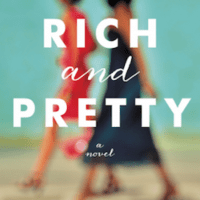Rumaan Alam’s debut novel is more than the Olive & Cocoa beach read that its cover promises it will be. A novel about the gradual mellowing of intimacy between two girls-turned-women, Sarah and Lauren—“rich” and “pretty,” respectively—Rich and Pretty mines terrain over which male novelists generally tread lightly. Alam fully commits, carefully navigating such third-rail subjects as body image and female libido as he sees a female friendship from its vibrant, vital inception through to a complacent early middle age.
The novel’s forward action spans the half dozen years between Sarah’s engagement and her second child. During this same period, Lauren gets promoted out of the cookbooks division of a New York City publishing house and remains almost entirely untouched by the marriage plot. Though she has boyfriends, one named Gabe whom the reader barely meets but whom Sarah is pretty sure Lauren should have married, Lauren never quite embraces the idea of the LTR.
As a child of privilege—the only child of a famous warmongering statesman and a Venezuelan-folk-singer-turned-socialite—Sarah has no choice but to get married. As the child of a mother who managed a doctor’s office and went into debt to send her daughter to a good prep school, Lauren has no choice but to succeed professionally.
But class, however ambient, doesn’t interest Alam as much as do the contours of female friendship. Though it sometimes bumps awkwardly against class difference, the friendship is not shaped by this difference so much as by a desire to keep open a path to prelapsarian girlhood:
[Lauren’s] friendship with Sarah has always been about nostalgia. At fifteen, it was about them at eleven; in college, it was about the tough-talking girls of fifteen they’d once been; in that shitty apartment in the East Village, it had been about the eager little undergraduate selves they’d sloughed off, the ones who flirted with socialism, or performance art.
At its best, this friendship allows Sarah and Lauren to transcend their present situations, to understand their lives as including but ultimately not being defined by the current moment. At its worst, the friendship blinds both to the inequality that shapes their lives, a blinding that benefits Sarah more than it does Lauren.
Though its back cover announces that the novel is “set in contemporary New York,” Rich and Pretty contains none of the excessive memorializing of Gotham that is characteristic of other recent NYC-set novels (Garth Risk Hallberg’s City on Fire, Sari Wilson’s Girl Through Glass, Stephanie Danler’s Sweetbitter). Readers have to rely on their mental maps of such places as the East Village and Park Slope. Likewise, we get to color in the contours of what it means that Lauren is “pretty.” While Sarah’s unattractive features (her “excess,” her broad shoulders) are named and described, Lauren’s prettiness is simply announced. If you go looking for its sources, you will find (like the novel’s cover) strategically-placed blurs onto which to project your own ideas about what “pretty” means. This choose-your-own beauty standard is not a copout. Alam’s strategy of detaching prettiness from specific social norms allows any number of readers to be Lauren, the undervalued though obviously more valuable foil for the ugly 1%ers. Would that this same democratization could be applied to rich.
And therein lies the problem with Rich and Pretty: its neutral representation of wealth amounts to a de facto endorsement of the kind of inequality that keeps the Laurens of the world stagnating in middle management. Lauren isn’t bothered (as much as I am) by Sarah’s vast, unearned wealth. Though she “has always been a little jealous of Sarah’s obliviousness to certain things,” Lauren barely acknowledges how unfair it is that her best friend’s biggest daily headache is that her wedding planner is passive aggressive. And Alam rewards Lauren for her imperturbability: She is the only character who has a healthy sex life, the only one who gets laid at Sarah’s tropical weekend bachelorette party.
Lauren is our girl, the foulmouthed desiring woman who navigates the upper crust with aplomb and is not afraid to say “fuck” or to daydream about hooking up with the cute temp—the hilarious rumination with which Alam opens the novel. She’s a Lady Brett stuck in cookbooks. Sarah, on the other hand, is the besieged princess who must survive the gauntlet of marriage and childrearing. Lauren, and by extension we readers, gets to scorn the sanctimony that society reserves for such mores. She gets to speak (or at least think) truth to power. But she is ultimately outshined by the radiant-if-predicable motherglow that marriage affords Sarah. More troubling, Lauren is silenced, never given an adequate occasion to defend her decision to not bend her life toward the marriage plot.
Sarah has played it safe. She’s been with the same nice guy since forever—a fat, boring nerd (surgeon) whose oak-like permanence exempts her from precarity and its attendant, consuming introspection. She is cared for to a fault, which leaves her with none of the allure of monadic Lauren. Rather than diminishing her as a character, this lack draws our sympathies: poor little rich girl. Lauren is the scholarship kid who thrived at prep school despite the odds, who passes with flying colors in Sarah’s world of alarming wealth, though she cringes a bit under the paternalistic arm of Sarah’s Rumsfeldian father. That Lauren is besieged by early-onset midcareer malaise is not a dramatic enough fate for us to shoot a glare of class bitterness at Sarah. To do so would mean punishing a woman who is guilty only of receiving privilege.
It’s not just beach novels that have lately softened in this way toward the 1%. Even recent potential national award finalists are asking us to stop worrying about inequality and love the rich: Sari Wilson’s Girl Through Glass, Edmund White’s Our Young Man, and Ramona Ausubel’s Sons and Daughters of Ease and Plenty assume easy identification with the accoutrement of affluence, of membership in such suspect institutions as Balanchine ballet, supermodeling, sailing, and/or summering.
This growing tolerance for the 1% in contemporary fiction, for narratives that ask us to be friendly with those who enjoy the highly inaccessible good life, is troubling. It’s not that fiction ought to punish aspirational impulses; there is a way for a summer read to channel aspiration without also tacitly endorsing inequality. But to do that it requires audacity—Winter Santiaga-level audacity—the kind of audacity that Alam neuters when he asks Lauren to sit there and look pretty while the rich daughters of captains of industry repopulate the world.
But I will grant Alam, and other recent inequality-agnostic novelists, one thing: They don’t reduce the Sarahs of the world to objects of easy ridicule. Perhaps fiction that conjures sympathy for the 1% is less regressive than it seems. Perhaps it will forge some path back to the now-ancient history of 2008’s spirit of national reconciliation, back to that blip of “we have never been just a collection of red states and blue states … we are and always will be the United States” idealism. Whether this urge isn’t itself another brand of toxic nostalgia is another matter.






One response
I hated this book. Paper-thin characters, totally artless prose.
Click here to subscribe today and leave your comment.